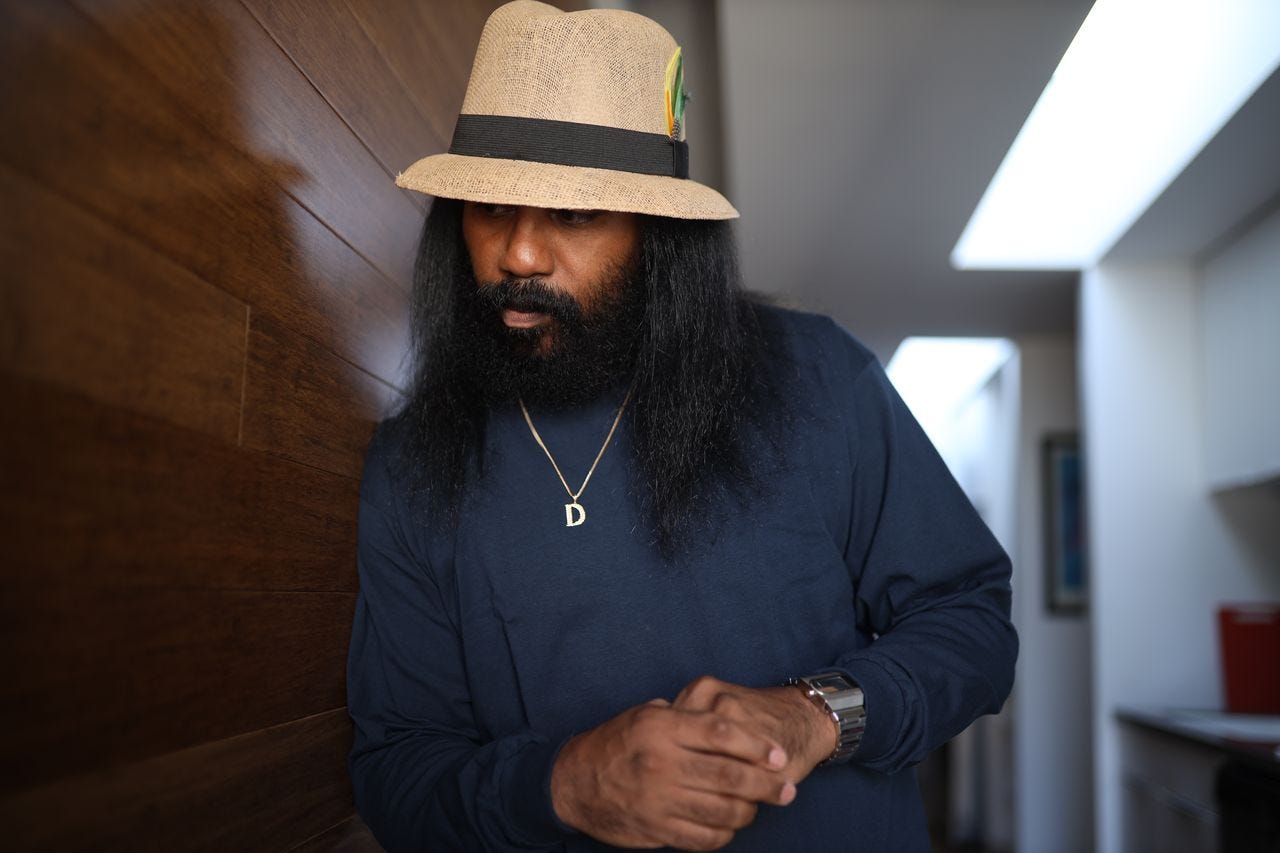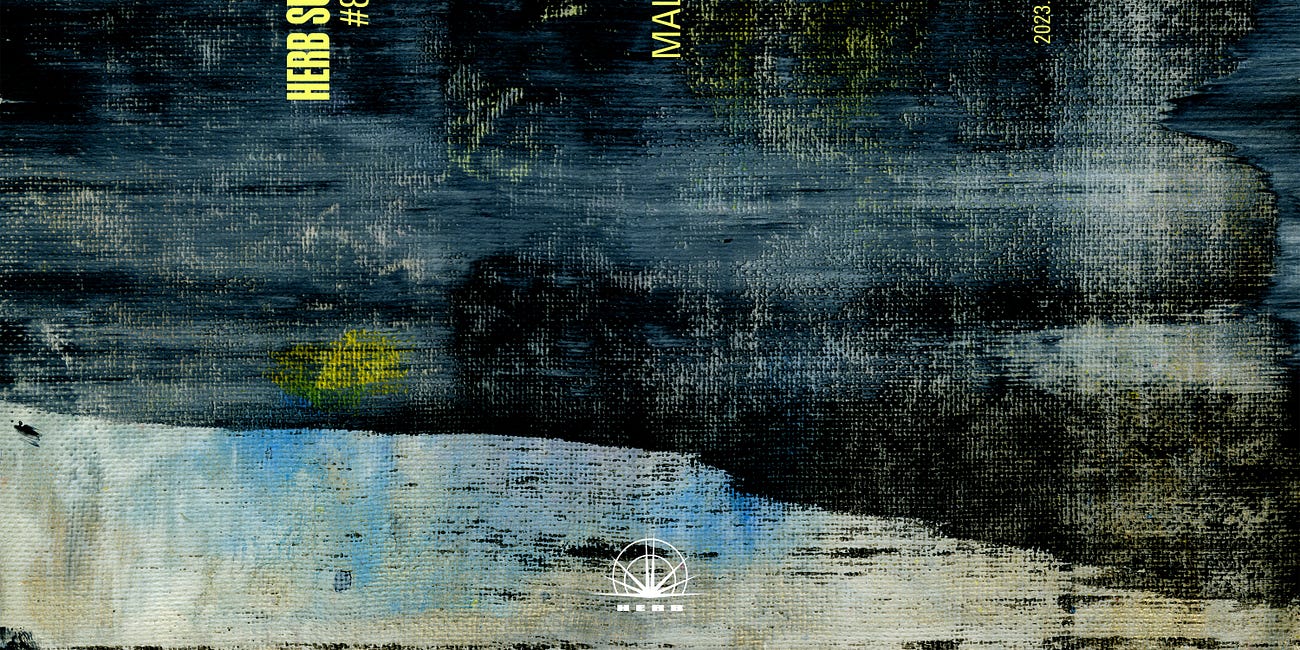Herb Sundays 148: DāM-FunK
The Los Angeles 'modern funk' icon in his drama-free element. “This is how I feel right now, in the moment, on this Sunday." + the sound that underpins everyone from J Dilla to Sabrina Carpenter.
Herb Sundays 148: DāM-FunK
Playlist: Apple Music, Spotify
Art by Michael Cina
“This is how I feel right now, in the moment, on this Sunday via these particular selections, in order. Growth. Appreciation. Chill. Looking forward 2 living more drama free life, no matter what’s going on in the world on this Sunday, (humbly) in my own lane out here. Wishing everyone listening the same. Peace.”
- DāM-FunK for Herb Sundays
When thinking about the Pasadena-born artist/producer/DJ/promoter DāM-FunK (pronounced “dame funk” for the uninitiated), it feels like he’s always been here. I always sensed there was more to his story hidden beneath the many accolades; for one, New York Magazine writer Craig Jenkins (Herb 84) called him our “our funk provost, our funk ambassador,” which I always liked a lot.
I then consulted the corpus of LA oracle Jeff Weiss, of course, who said: “I’ve written about Dam’s music too many times and that I’m out of adjectives. If you don’t live in LA, you might not understand. His songs and his mixes intuitively convert the sunlight and wind into neon synthesizers and asphalt drum machines. Dam-Funk’s music sounds like a Palm looks or when Sunset exhales onto PCH and the ocean emerges laced with diamond clusters. This is a cliche in its own right, but Dam’s genius lies in his ability to undermine cliches, and resurrect an entire genre that most consigned to the graveyard.”
OK, perfect, no notes.
The genre in question is a melange of ‘70s and ‘80s Black music that has always evaded a name, a melange of soul, funk, electro, and boogie disco he has dubbed “Modern Funk” that happens to be amongst my favorite corners of music. He’s been on my To Herb list for years thanks to this curatorial sensibility, but also for his Herb philosophical bonafides, as a flower-giver to the overlooked producers and session musicians of this era, and his philosophy, The Tao of DāM-FunK, if you will, of staying the course, humbly. For my
interview last year, I shared that I took some degree of solace in the random musings of the man, a stay in your lane and keep your head down mindset, a kindly esprit de corps in an era of endless takes.His pitch-perfect style, like his sound, can come across as pastiche to the uniformed; he’s not an Encino Man (1992) of American retro-futurism, instead he’s a living Tomb of the Unknown Soldier for an era of excellence and musical exploration that the industry quickly moved past in favor another favorite zone of mine, Hip-Hop.
Mentored by legendary producer Leon Sylvers III (search the SOLAR label for more) and raised in the cultural magic of adjacent Los Angeles, loving the many local heavy and hair metal records, going to buy KISS posters with his aunt on the Sunset Strip, and buying up promo copies of bands like Depeche Mode at his local Pasadena record store haunts, or those affordable but beautiful 12” singles cast aside by the area’s numerous record execs. He absorbed every credit and every liner note and carried it forward. As an adult, he wanted to put this sound on the map and co-founded the legendary club night Funkmosphere in 2006, on some Field of Dreams (1989) shit, which helped get the incredible Stones Throw label involved and set his solo career ablaze.
He would then found his own Glydezone label and production company and the hits coming, including collaborations with Rockstar Games’ Grand Theft Auto franchise, a radio show with Apple Music, projects with brands like Stussy and Born X Raised, and more, all while making records with and remixing everyone from Jody Watley, to Animal Collective (“I really respect those dudes and wanted to get down with them. For lack of a better description, they sort of remind me of Talking Heads”) to Nite Jewel, Snoop Dogg and HEALTH.
His preferred sound comes from a lineage of L.A. staple elements that somehow are less famous than the prominent Funk icons (i.e. the P-Funk lineage, which appears on his playlist as an amazing George Clinton rarirty) or tropes (Funk as as percieved disco novelty, a piss take from a dusty greeting card), including the Uncle Jamm’s Army parties, the strangely elegiac ‘80s electro of artists like Egyptian Lover and other moments from the shiny pre-NWA Dr. Dre era, and the musicianship that surrounded it.
While the Yacht Rock: A Dockumentary (2024) film wasn’t a hit for some, I loved what it represented, which isn’t far away from this story. The proliferation of great session musicians and studios that backed those records often came from jazz and funk backgrounds and would produce the same aural sheen of those records alongside the “Modern Funk” ones
loves. In looking back, I realized it was indeed Mike Cina himself who set me on this path over a decade ago, sending me a CD-R (yep) from Prince country Minneapolis/St. Paul that said “Melancholy Funk,” which collected these synthy pop-soul records that I didn’t know went together.You start to realize that instead of standing on some perceived image of success, Dam’s in fact a stalwart of what was seen as a commercial failure. The segration of popular music meant that the only way Black artists could get on the charts was through other genre forms like soft rock or lite jazz (See Cina’s Smooth Jazz Herb 135 for more on that). I then remembered that this Herb Sundays actually has a forebear, from Dilla Time author Dan Charnas, who has a verbal bone to pick with the fact that this sound never got a fair shot. From his Herb 56 playlist quote:
In America, back then, nobody ever called it boogie: it was funk or soul. But the term is interesting in that it shows how those artists’ voicelessness continues even now. We’ve given them a name they themselves never used and never asked for.
One of my great delights during the writing of Dilla Time was discovering the mix tape (Spotify) that Jay Dee gave to Peter Adarkwah during the making of Welcome 2 Detroit. I realized that James, whom I met and worked with only once, and I had some similar tastes, centered around this precious musical period, the one right after disco and right before Michael Jackson and Prince’s Great Crossover changed the texture of Black music yet again.
The more I think about it, in the funk of the early 1980s (or boogie if you must) we witness a fruitful, once-in-a-lifetime negotiation between machine time and human time, between synthesis and human sounds, and it makes perfect sense that this era was interesting to James in particular: four on the floor, but still on the One. Driven by a machine-like pulse and by synthetic sounds, but always soulful.
He then wrote about it in Slate last year, how the song of last year was indeed prototyped on one of these cuts, in The Musical History Lesson Buried Beneath the Song of the Summer: “Sabrina Carpenter’s “Espresso” is one of several recent hits bringing back the genre that never got a name. But “Espresso,” frankly, belongs to the summer of 1982. Pretty much every musical idea in America’s Pop Song of the Moment can be traced back to an entire genre of music that, in its own time, was resoundingly rejected as “not pop enough” by radio and MTV. Ironic indeed that so much pop in the past couple of years, whether it’s Mark Ronson and Bruno Mars’ “Uptown Funk!,” Dua Lipa’s Barbie soundtrack entry “Dance the Night,” or Doja Cat’s SZA team-up “Kiss Me More,” derives from this musical movement that never even had a name of its own…”
So while DāM-FunK is humbly in his lane, there is something bigger happening when you see him pop up. It’s a reckoning for a forgotten sound, including all the players, the makers, the dreamers. Sometimes, you need a living symbol to remember it all.
Bonus Beats: Herbs In The News
The excellence of Malibu’s (Herb 82) NTS Radio show was profiled by
for Pitchfork: “The world Malibu conjures on her long-running NTS show seems to exist solely between twilight and dawn. She draws from her own database of achingly gorgeous edits, where vocals are swathed in reverb or stretched to sound like angel choirs, and slips them alongside deep cuts from Orbital or Basic Channel, big trance anthems looped to stop short of the drop, whispered pop melodies that dissolve like ocean spray, or a muffled field recording of a fireworks display.”Revisit Malibu’s Herb Sundays here:
Herb Sundays 82: Malibu
Herb Sundays 82: Malibu (Apple, Spotify, Tidal, Amazon). Art by Michael Cina.













any fan of horsin around by prefab sprout has a friend in me
Yesssss❤️🔥